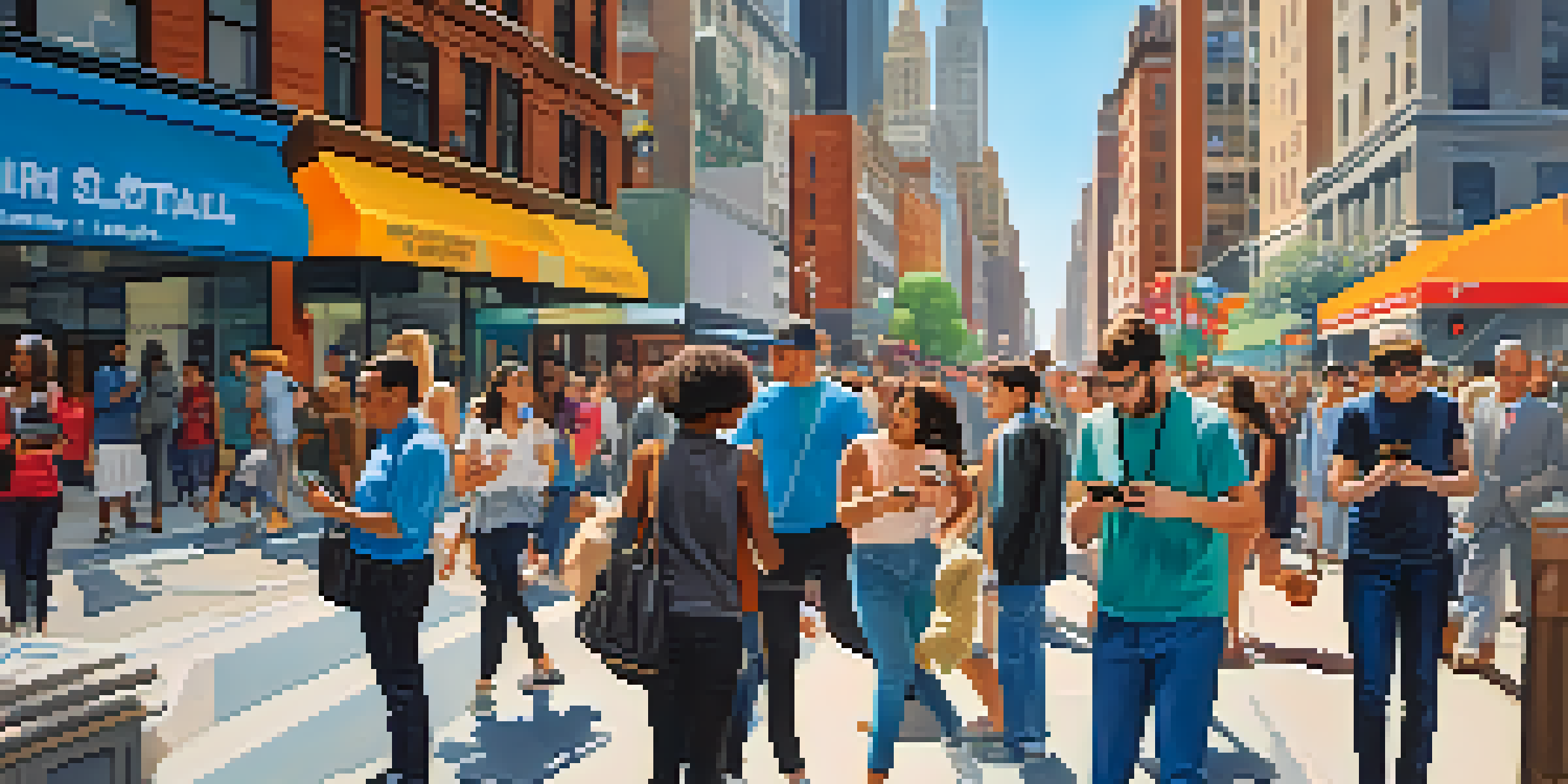Engaging Citizens: The Impact of Apps on NYC Civic Life

The Rise of Civic Tech in New York City
In recent years, New York City has witnessed a surge in civic technology, particularly through mobile applications. These tools have empowered citizens to engage more deeply with their local government, making it easier than ever to voice opinions and report issues. With the tap of a finger, residents can connect with elected officials and participate in community discussions.
Technology is best when it brings people together.
This rise of civic tech isn't just a trend; it's a movement towards transparency and accountability. By harnessing the power of technology, NYC is redefining how citizens interact with their city. This shift allows for greater inclusivity, ensuring that diverse voices are heard in the decision-making process.
Moreover, the accessibility of these apps means that more New Yorkers can participate, regardless of their background or tech-savviness. The digital landscape is leveling the playing field, encouraging active participation in civic life across the city.
How Apps Facilitate Citizen Reporting
One of the most impactful aspects of civic apps is their ability to streamline citizen reporting. Applications like 311 allow residents to report issues such as potholes, broken streetlights, or noise complaints directly to the city. This not only speeds up the response time but also provides a sense of empowerment to users who can actively contribute to their community's upkeep.

When citizens can quickly report concerns, it fosters a culture of accountability within local government. Officials are more likely to respond promptly when they know that residents are actively monitoring their environment. This two-way communication fosters trust and encourages ongoing dialogue between citizens and their representatives.
Empowering Citizens with Apps
Civic technology in NYC is enabling residents to engage actively with local government, fostering transparency and accountability.
Additionally, many of these apps provide real-time updates on reported issues, keeping citizens informed and engaged. This transparency reinforces the idea that every voice matters and that collective action can lead to visible improvements in the community.
Enhancing Community Engagement Through Feedback
Civic apps have taken community engagement to the next level by facilitating feedback loops. Through platforms like NYC’s participatory budgeting app, residents can propose and vote on projects that impact their neighborhoods. This direct involvement in budget decisions makes citizens feel more connected to their local government.
The only way to do great work is to love what you do.
Feedback mechanisms allow for ongoing conversations about local needs and priorities. Rather than feeling like passive observers, residents become active participants in shaping their communities. This sense of ownership helps to cultivate a more engaged and informed citizenry.
Furthermore, feedback collected through these apps can help city officials gauge public opinion on various initiatives. By analyzing this data, they can make more informed decisions that align with the community's desires and needs.
Promoting Accessibility and Inclusivity
In a city as diverse as New York, promoting accessibility and inclusivity through civic apps is crucial. Many applications are designed with user-friendly interfaces that cater to individuals of varying tech abilities. This attention to accessibility ensures that all citizens, including those with disabilities, can participate in civic life.
Moreover, some apps offer language options to accommodate non-English speakers, ensuring that language barriers do not hinder participation. This inclusivity is vital for fostering a sense of belonging among all residents, regardless of their background.
Enhancing Community Participation
Feedback loops through civic apps encourage residents to propose and vote on local projects, making them active participants in governance.
By prioritizing accessibility, these apps help bridge the gap between city officials and the communities they serve. When everyone has a voice, the result is a richer, more vibrant civic life that reflects the true diversity of New York City.
Building Trust Through Transparency
Transparency is a cornerstone of effective governance, and civic apps play a pivotal role in enhancing this principle. By providing easy access to information about city initiatives, budgets, and decision-making processes, these apps empower citizens to stay informed. This transparency helps to demystify government operations and builds trust between citizens and their leaders.
When residents can easily track the progress of reported issues or understand how their tax dollars are being spent, they feel more connected to their government. This connection fosters a sense of accountability among officials, as they know citizens are watching and engaged.
Ultimately, this transparency cultivates a more informed electorate, encouraging citizens to participate in discussions and advocate for their communities. A transparent government is one that inspires confidence and encourages active civic engagement.
The Role of Social Media in Civic Engagement
Social media platforms have become an integral part of civic engagement, complementing the functionality of civic apps. Many city agencies leverage social media to disseminate information and engage with residents in real-time. This combination of platforms allows for a broader reach, ensuring that important updates are communicated effectively.
Furthermore, social media acts as a catalyst for community discussions. Residents can share their thoughts, concerns, and experiences, fostering a sense of community and solidarity. This online engagement often spills over into offline action, as citizens become motivated to participate in local events or advocacy efforts.
Future of Civic Tech Looks Bright
Emerging technologies like AI and augmented reality promise to further transform civic engagement and enhance community interaction in New York City.
By integrating social media with civic apps, cities can create a more dynamic and interactive civic experience. This synergy not only keeps citizens informed but also encourages them to engage with one another, building a stronger sense of community.
Future Trends in Civic Technology for NYC
As technology continues to evolve, the future of civic engagement in NYC looks promising. Emerging trends, such as artificial intelligence and data analytics, are set to enhance the capabilities of civic apps even further. These advancements can provide city officials with valuable insights into community needs and preferences, leading to more tailored services.
Moreover, the integration of augmented reality (AR) in civic apps could transform how residents interact with their environment. Imagine using an app to visualize future community projects or see the impact of past initiatives in real-time. This immersive experience can deepen engagement and foster a stronger connection to local governance.

Ultimately, the continued evolution of civic tech will depend on community input and collaboration. As New Yorkers embrace these innovations, they will play a crucial role in shaping the future of their city and ensuring that civic engagement remains vibrant and meaningful.